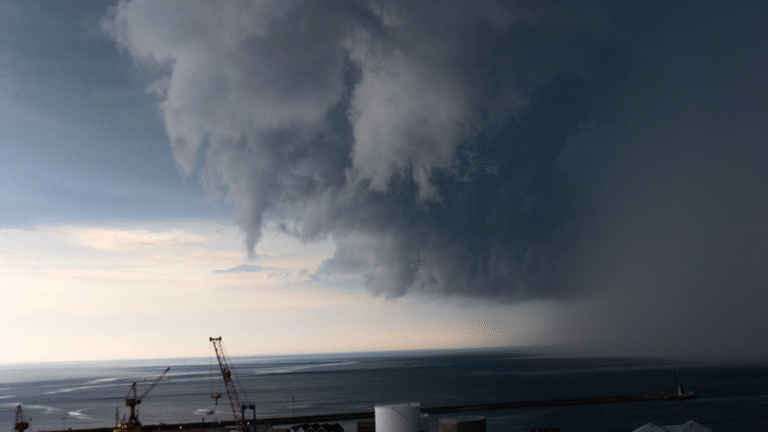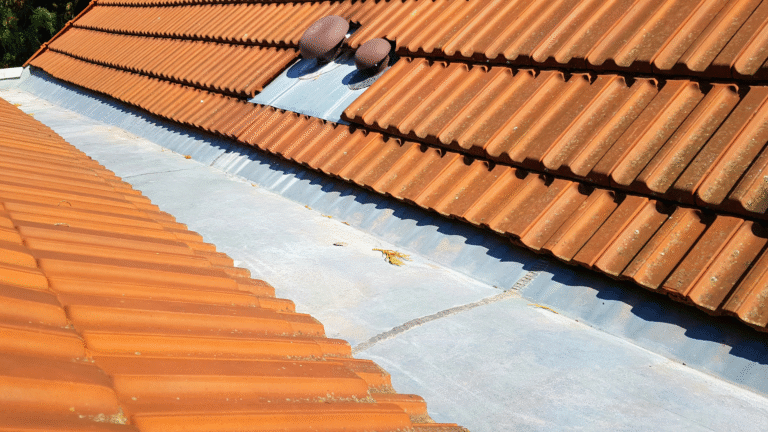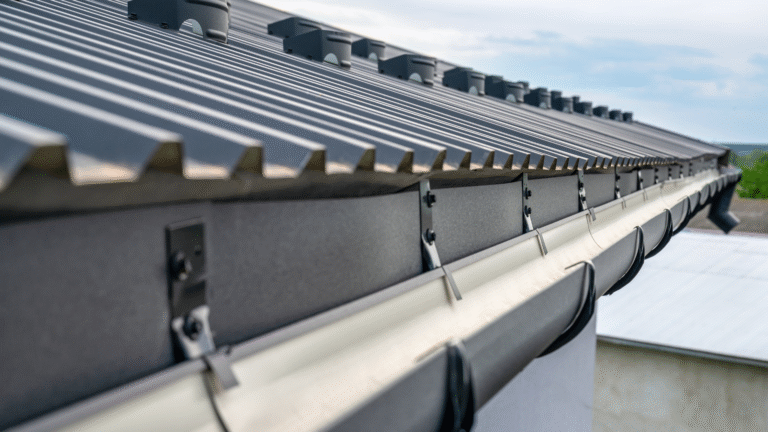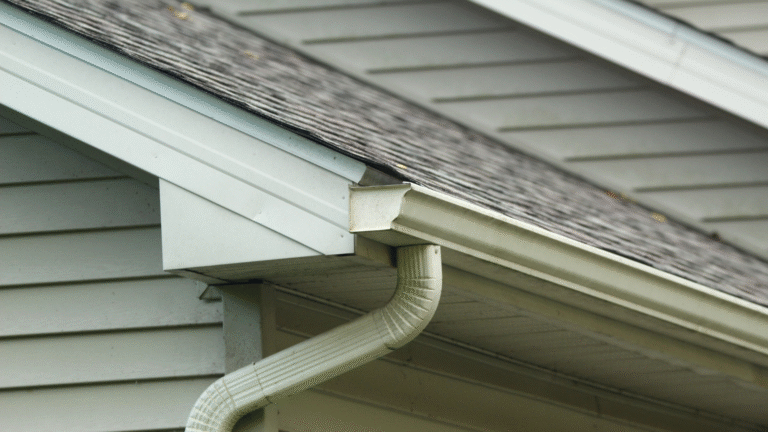New Jersey’s Coastal Weather climate combines several environmental forces that create serious challenges for home exteriors—especially gutter systems. Located along the Atlantic Ocean, NJ faces constant exposure to salty ocean air, heavy rainfall, high winds, humidity, and periodic snowstorms. These conditions actively wear down gutter systems and reduce their effectiveness over time. Homeowners in coastal cities like Atlantic City, Ocean City, and Long Branch must understand how these weather patterns impact their gutters.
Gutters actively defend homes against water damage, but coastal conditions can weaken their structure and trigger issues like foundation cracks, siding deterioration, and mold growth. Salt exposure and constant moisture demand the use of durable, weather-resistant gutter materials. In this article, we’ll explore how each aspect of New Jersey’s Coastal Weather affects gutter systems and reveal the most effective solutions for long-term protection.
Salt Air and Corrosion: A Coastal Concern
Salt air poses one of the most serious threats to gutter systems in Coastal Weather New Jersey. Salty sea breezes constantly expose shoreline homes to fine salt particles that cling to exterior surfaces. These particles settle on gutter materials—especially metal—and rapidly accelerate oxidation and corrosion. Salt quickly eats through protective coatings on galvanized steel and zinc-coated gutters, causing rust, pitting, and structural weakening.
Even painted finishes fail under prolonged salt exposure, often peeling or blistering over time. Coastal towns like Cape May, Point Pleasant, and Seaside Heights experience much faster gutter deterioration than inland areas due to this relentless exposure. That’s why homeowners in these regions must choose gutter materials designed to resist salt damage. Those who overlook this critical factor often face premature failures, water leaks, and frequent repairs. By investing in corrosion-resistant materials upfront, homeowners ensure longer-lasting performance in New Jersey’s salty, humid environment.
Heavy Rainfall and Its Impact on Gutter Functionality
Heavy rainfall frequently challenges New Jersey homeowners, especially those along the coast. During spring and fall, coastal towns like Asbury Park, Toms River, and Wildwood often endure intense downpours that quickly overwhelm undersized or poorly maintained gutter systems. When gutters lack the capacity to handle large volumes of water, they overflow and spill runoff near the foundation. This overflow causes serious structural problems, including basement flooding, soil erosion, and foundation cracks.
Runoff that escapes the gutter system also rots fascia boards, damages siding, and fosters mold and mildew growth. To prevent these issues, homeowners must install high-capacity gutters, often paired with oversized downspouts, to efficiently direct water away from the roof and foundation—even during torrential coastal storms. In low-lying areas or properties with poor drainage, these risks increase, making well-designed, properly maintained gutter systems essential for safeguarding homes in New Jersey’s unpredictable coastal weather.
Strong Winds and Storm Surges: Physical Gutter Damage
New Jersey’s coastal regions are frequently subjected to strong winds and storm surges, particularly during the Atlantic hurricane season. These powerful forces can inflict serious physical damage on gutter systems, especially when wind gusts exceed 60 to 70 mph. In towns like Brick Township, Belmar, and Ventnor City, wind-borne debris—such as branches, shingles, and sand—can dent, clog, or completely tear gutters from their fastenings. Gutters that are poorly secured or aged are especially prone to detachment under high-pressure gusts. Storm surges, which bring flooding and rapid water movement, can further compromise gutters by dislodging downspouts and saturating the soil around anchor points.
This weakens the system’s structural integrity and increases the likelihood of collapse. In severe cases, entire gutter runs can be ripped away from the fascia, leaving homes vulnerable to unchecked water intrusion. For coastal homeowners in New Jersey, reinforcing gutter brackets, using wind-rated materials, and ensuring a tight seal between gutter joints is critical. These precautions not only protect your investment but also reduce the likelihood of costly emergency repairs after a major storm.
Snow and Ice: Winter Weather Threats to Gutters
Ice Dams and Weight Stress
Winter weather in coastal New Jersey may not bring the heaviest snowfalls compared to inland areas, but it still poses a serious threat to gutter systems—particularly through the formation of ice dams. When snow accumulates on the roof and begins to melt during the day, the water runs into cold gutters and refreezes at night. This repeated freeze-thaw cycle forms blockages that prevent water from flowing properly. Over time, these ice dams grow heavier and exert significant stress on the gutter brackets and fasteners, often pulling them away from the fascia or bending the metal.
In areas like Red Bank, Long Beach Island, and Highlands, fluctuating winter temperatures make ice dam formation a recurring problem. This weight stress can lead to sagging gutters, broken joints, and even full detachment. To mitigate this issue, homeowners should ensure proper attic insulation, install heated gutter cables if needed, and conduct regular winter inspections to prevent buildup.
Freezing and Cracking in Vinyl Gutters
Vinyl gutters, while popular for their affordability and ease of installation, are particularly vulnerable in coastal New Jersey winters. As temperatures drop below freezing, vinyl becomes brittle, making it prone to cracking under pressure or sudden impact. Ice formation within the gutters adds to the internal pressure, which can split seams and joints, leading to water leakage when the system eventually thaws. Unlike aluminum or copper, vinyl lacks the strength to withstand fluctuating coastal temperatures combined with winter precipitation.
In coastal towns such as Bay Head and Sea Bright, where freezing rain and sleet are common, vinyl gutters may only last a few seasons before needing replacement. The coastal wind chill further exacerbates these issues, making it critical for homeowners to choose weather-resistant alternatives. Upgrading to aluminum or copper gutters, which perform better in cold weather, can help ensure a longer-lasting and more resilient system for coastal winter conditions.
Coastal Erosion and Home Elevation Changes
Coastal erosion is a gradual yet powerful force that affects both the land and the structures built on it—including the performance of gutter systems. In New Jersey shoreline communities like Ortley Beach, Lavallette, and Union Beach, shifting soil caused by tides, flooding, and storm surges can subtly alter the elevation or slope of a property over time. When the foundation of a home settles unevenly due to erosion, it can cause gutter systems to lose their proper pitch and alignment.
A gutter that was once angled correctly to channel water away from the home may suddenly begin to pool water or drain inefficiently. Even slight misalignments can result in overflow issues, downspout backups, or water runoff that damages landscaping and the home’s foundation. Additionally, homes raised on pilings for flood protection may experience stress where gutter downspouts meet the shifting ground below, leading to cracks, detachment, or redirection of water flow. These subtle elevation changes highlight the importance of periodic gutter inspections for coastal properties, ensuring the system is realigned and functioning properly despite the evolving terrain.
Salt-Resistant and Weather-Resistant Gutter Materials
Aluminum Gutters
Naturally resistant to rust and corrosion, making them ideal for coastal climates
Lightweight yet strong, able to withstand wind and salt exposure
Can be coated or painted for additional durability
Long-lasting performance even with minimal maintenance
One of the most popular choices for NJ coastal homeowners due to cost-efficiency
Easy to install and compatible with seamless designs
Performs well in both summer humidity and winter freezes
Copper Gutters
Highly resistant to corrosion and unaffected by salt air
Naturally develops a protective patina that shields it from weather damage
Offers unmatched longevity—often lasting over 50 years
A premium material, ideal for historic or luxury coastal homes
Less likely to warp or dent under strong winds or heavy rains
Minimal maintenance required despite harsh environments
More expensive upfront but delivers long-term savings
Vinyl Gutters
The least durable option in coastal conditions
Prone to cracking in cold temperatures and warping under UV exposure
Not corrosion-prone, but salt and wind can cause premature wear
Lightweight and easy to install, but often not worth it in high-risk coastal zones
May fade or weaken faster due to salt residue accumulation
Best suited for low-budget or inland applications
Not recommended for areas frequently affected by storms or salt spray
Seamless Gutters: A Smart Choice for Coastal NJ
For homeowners living along New Jersey’s coast, seamless gutters offer a reliable and durable solution that’s well-suited for harsh maritime conditions. Unlike sectional gutters, which are assembled from multiple smaller pieces, seamless gutters are custom-fabricated in long, continuous runs, reducing the number of joints where leaks typically occur. This design feature is particularly beneficial in coastal towns like Manasquan, Sea Isle City, and Ocean Grove, where high humidity and frequent storms can rapidly degrade traditional systems. Fewer seams mean fewer opportunities for salt-laden moisture to penetrate and cause internal rust or joint separation.
Seamless aluminum gutters are especially popular in these regions due to their resistance to salt corrosion and their ability to handle heavy rainfall efficiently. Additionally, seamless gutters can be securely fastened to withstand coastal winds, making them a resilient choice during nor’easters and tropical storms. Their custom fit also enhances curb appeal by maintaining a clean, uniform appearance. Overall, seamless gutters are not only a practical investment but also a proactive defense against the climate challenges faced by New Jersey’s shoreline homes.
The Role of Gutter Guards and Protection Systems
- Gutter guards block leaves, pine needles, and debris—crucial in areas with strong coastal winds.
They prevent salt residue and organic matter from corroding your gutter system.
They keep water flowing smoothly by minimizing clogs during heavy coastal rains.
Gutter protection systems extend the lifespan of gutters by reducing rust and internal water buildup.
They eliminate frequent manual cleaning, helping you save time and maintenance costs.
By promoting better drainage, they help prevent ice dams in winter.
They deter birds and insects from nesting in gutters, especially in warmer coastal climates.
During hurricane season, they keep gutters free from flying debris.
Seamless gutter systems benefit the most from gutter guards, enhancing their overall efficiency.
Gutter guards come in durable materials like stainless steel, aluminum, and mesh to withstand coastal conditions.
They boost gutter performance during seasonal storms and stop overflow or backup.
They add rigidity to the top of gutters, increasing structural strength.
You can retrofit gutter guards to existing systems with minimal effort.
They resist warping under intense sunlight and salt air exposure.
Gutter guards make a smart upgrade for homes in New Jersey’s high-moisture, high-debris coastal zones.
Regular Gutter Maintenance for Coastal Homes
Cleaning Frequency in Salty, Windy Areas
In coastal New Jersey, where high winds and salt air are a constant, gutter maintenance should be more frequent than in inland areas. Homeowners in towns like Avalon, Barnegat Light, and Margate City should inspect and clean their gutters at least three to four times a year, rather than the typical twice-a-year recommendation. Coastal winds carry sand, leaves, pine needles, and salt particles that easily clog gutters and form blockages. Without routine cleaning, this debris can trap moisture and accelerate corrosion, especially in metal systems.
Additionally, salt deposits can build up over time and create a sticky film that clings to the interior, attracting even more particles. Consistent cleaning ensures water flows efficiently through the system and reduces the risk of overflow or damage to the siding and foundation. Professional cleaning is often recommended for coastal homes, as experts can safely access hard-to-reach areas and identify early signs of wear or misalignment caused by environmental factors.
Inspection After Storms
Following coastal storms—whether a heavy thunderstorm or a post-tropical cyclone—New Jersey homeowners must inspect their gutter systems for any signs of damage. After a storm, gutters may be misaligned, filled with debris, or partially detached from the fascia. High winds and flying debris can also dent or puncture gutter channels, creating potential leak points. In regions like Cape May Point or Sea Girt, where storm activity is frequent, it’s especially important to check for saltwater exposure that may not be immediately visible but begins corroding the material quickly.
Regular post-storm inspections help identify problems early, preventing small issues from escalating into expensive repairs. Homeowners should look for sagging sections, disconnected downspouts, loose brackets, and standing water. Professional inspections following major weather events can provide a thorough assessment and ensure that any minor repairs are addressed before the next storm hits. This proactive approach helps preserve the gutter’s integrity and protects the home from long-term water damage.
Local Gutter Installation Tips for NJ Coastal Zones
Installing gutter systems in New Jersey’s coastal zones requires specific considerations that go beyond basic home improvement practices. Due to frequent exposure to wind, salt air, and heavy rainfall, installation methods must prioritize both durability and long-term performance. Homes in coastal areas such as Lavallette, Longport, and Sea Bright must comply with local building codes, especially those related to flood zones and wind resistance. This includes using stainless steel or marine-grade fasteners that won’t corrode, and ensuring gutters are pitched correctly to allow swift water evacuation. Larger 6-inch gutters are often preferred over standard 5-inch ones to accommodate the intense rainfall common in the region.
Downspouts should be wider and strategically placed to avoid water pooling near the home’s foundation, especially on sloped or shifting lots. Installers should also anchor gutters securely using heavy-duty brackets spaced more closely than usual to withstand high winds. Additionally, when installing on raised or pile-supported homes, downspouts must be adjusted to accommodate elevation changes and prevent stress or damage to the piping. Hiring local professionals familiar with New Jersey’s coastal climate ensures that installation is both code-compliant and built to endure the region’s unique weather conditions.
Conclusion:
Living in coastal New Jersey comes with undeniable charm—but also distinct challenges for homeowners, especially when it comes to exterior maintenance. Gutter systems are one of the most critical defenses against the harsh effects of salt air, storm surges, heavy rainfall, and seasonal freezes. Without proper design, materials, and maintenance, these systems can quickly degrade, leading to water damage, structural issues, and unnecessary repair costs. From corrosion caused by salt exposure to physical stress from wind and ice, the coastal environment places high demands on gutters.
Choosing salt- and weather-resistant materials like aluminum or copper, installing seamless systems, and reinforcing them with gutter guards are proactive steps every coastal homeowner should consider. Routine inspections—especially after storms—and professional installations tailored to New Jersey’s coastal conditions can significantly extend the lifespan of your gutters. In the end, a well-maintained and properly designed gutter system doesn’t just protect your roof—it safeguards your entire home. Investing in your gutters is investing in the long-term durability and safety of your property in the Garden State’s beautiful but demanding shoreline environment.







